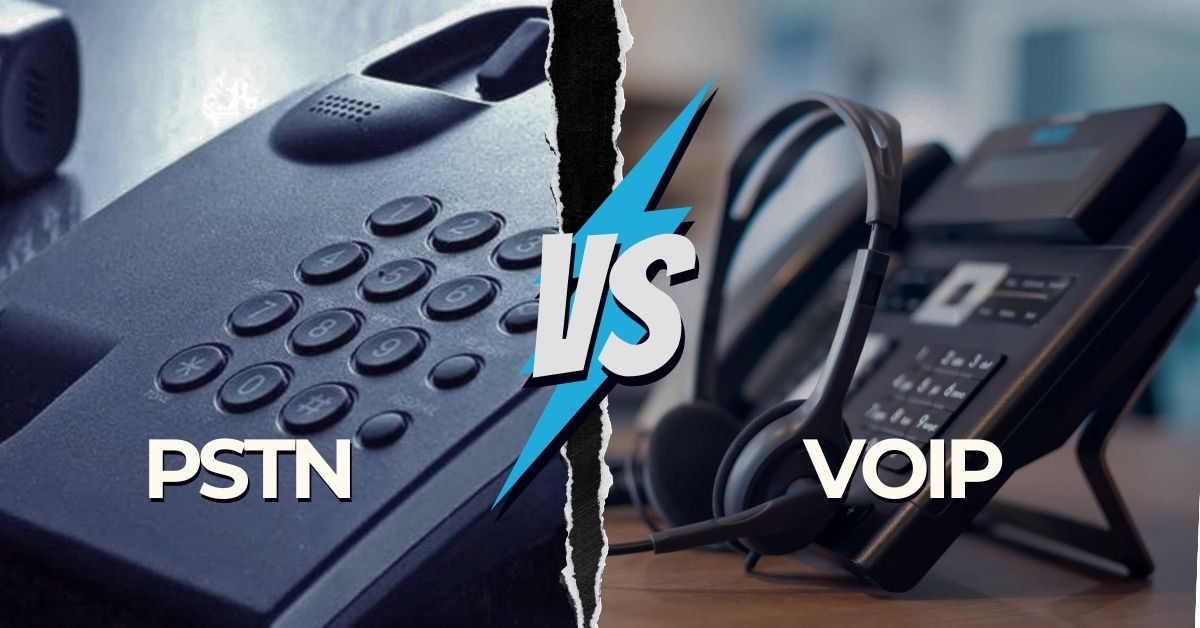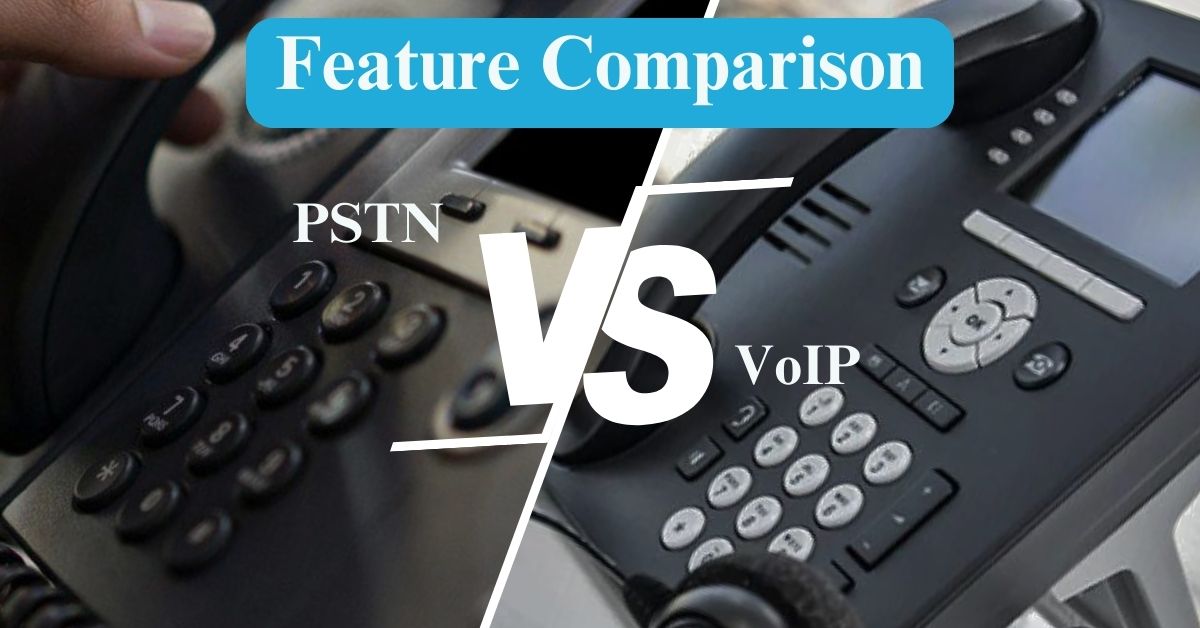One of the most famous technologies in this modern business world is VOIP (Voice Over Internet Protocol). With the help of VoIP businesses don’t need to be afraid of missing any important call anymore.
However, between PSTN and VoIP, which one is better for your business? In this article we will dissect every single aspect of PSTN vs VoIP and help you understand which one is better for your business.
What Is PSTN?

PSTN (The Public Switched Telephone Network) is the traditional backbone of telephony, connecting landline phones worldwide through a network of copper wires, fiber-optic cables, and switching centers.
Established long before the digital age, PSTN relies on analog signals to transmit voice communications. When a call is made, the network uses dedicated physical circuits to establish a continuous connection between the caller and the recipient.
Known for its reliability and consistent call quality, PSTN has been the foundation of global voice communication for decades. However, its rigid infrastructure and higher maintenance costs make it less flexible compared to modern digital alternatives like VoIP.
How Do PSTN Telephone Lines Work?

The Public Switched Telephone Network (PSTN) operates through a vast network of interconnected lines and switches that enable voice communication between any two telephones. Here’s a detailed look at how PSTN telephone lines work:
1. Telephone Lines and Local Exchanges:
When you pick up a traditional landline phone, it connects to your local exchange via a pair of copper wires. This local exchange is the first point of contact in the PSTN system, managing calls within a specific geographic area.
2. Initiating a Call:
Dialing a phone number sends a signal to the local exchange, which identifies the destination number. If the call is local, the exchange routes it directly. For long-distance and international calls, the signal is sent to a higher-level exchange.
3. Call Routing:
The local exchange communicates with other exchanges to find the most efficient path for the call. This process might involve several intermediate exchanges, particularly for international calls. Each exchange acts as a switch, directing the call towards its destination.
4. Establishing the Connection:
Once the path is determined, the exchanges establish a circuit, creating a dedicated line for the duration of the call. This circuit-switching ensures a continuous and stable connection, which is a hallmark of PSTN’s reliability.
5. Transmitting Voice Signals:
During the call, analog voice signals are transmitted through the established circuit. These signals travel over copper wires and, in some cases, fiber-optic cables, ensuring clear voice transmission.
6. Signaling and Supervisory Functions:
Throughout the call, signaling information (such as dial tones, busy signals, and call termination signals) is sent alongside voice signals. Supervisory functions monitor the line’s status, ensuring the connection remains stable and terminating the call when either party hangs up.
7. Disconnecting the Call:
When the call ends, the circuit is released, freeing up the resources for other calls. The exchanges update their records, and the signaling process notifies all involved exchanges to disconnect the dedicated line.
The switched telephone network PSTN system, while rooted in older technology, is a robust and reliable method for voice communication, providing consistent call quality through its dedicated circuit-switched connections.
Despite its reliability, the system’s inherent inflexibility and higher operational costs have paved the way for more modern solutions like VoIP.
What Is VoIP?
Voice over Internet Protocol (VoIP) is a modern telecommunication technology that enables voice calls to be made over the Internet rather than through traditional analog phone lines.
By converting analog voice signals into digital data packets, VoIP allows these packets to be transmitted via broadband connections to reach their destination.
This digital approach not only reduces costs significantly but also offers enhanced flexibility and scalability. VoIP supports a range of advanced features such as video calls, voicemail-to-email, and seamless integration with other digital services like customer relationship management (CRM) systems.
With its ability to support remote work and mobile communication, VoIP has become an increasingly popular choice for businesses looking to upgrade their communication systems.
How Do VoIP Calls Work?

VoIP calls work by converting your voice into digital data packets that are transmitted over the internet. Here’s a brief step-by-step overview:
1. Initiating the Call:
– When you make a VoIP call using an IP phone or a softphone app, your voice is converted from analog to digital format by a device called an analog-to-digital converter.
2. Data Packet Transmission:
– The digital voice data is then broken into small packets. Each packet contains a portion of the voice data along with information about its destination.
3. Routing the Call:
– These packets travel over the internet via routers and switches, finding the most efficient path to the recipient’s device.
4. Reassembling the Data:
– At the recipient’s end, the digital packets are reassembled in the correct order by the device, and converted back into analog signals if necessary, allowing the recipient to hear your voice clearly.
5. Handling Call Management:
– VoIP servers and protocols like SIP (Session Initiation Protocol) manage call setup, routing, and termination, ensuring seamless connectivity and call quality.
This efficient process allows VoIP to provide clear, reliable communication, often with added features that desk phone lines cannot offer.
How VoIP Helps Your Business
Internet protocol VoIP is revolutionizing business communication by offering a range of benefits that plain old telephone service pots cannot match. Here’s a detailed look at in PSTN vs VoIP, how VoIP can significantly enhance your business operations:
1. Cost Savings
One of the most compelling advantages of VoIP is the reduction in communication costs. Traditional phone lines often incur high charges for long-distance and international calls.
In contrast, VoIP uses the internet to transmit voice data, which significantly lowers these costs.
Many VoIP providers offer subscription-based pricing models, which can include unlimited calling plans. Additionally, the maintenance and operational costs of VoIP systems are generally lower than those of traditional PSTN systems, as they require less physical infrastructure.
2. Scalability
As your business grows, so do your communication needs. VoIP systems are inherently scalable, allowing you to easily add or remove lines as needed. Unlike traditional phone services, which often require physical wiring and new hardware, VoIP systems can expand through simple software configurations.
This flexibility makes it easy for businesses to scale up during peak seasons or scale down when necessary, without significant investment.
3. Advanced Features
VoIP offers a suite of advanced features that enhance productivity and customer service. Features such as call forwarding, voicemail-to-email, video conferencing, auto-attendant, emergency services and interactive voice response (IVR) systems are standard with most VoIP services.
These tools facilitate better call management and ensure that rout callls to the appropriate departments or individuals, thereby improving customer experience and operational efficiency.
4. Mobility and Remote Work
In today’s business environment, the ability to work remotely is crucial. VoIP supports mobile and remote work by allowing employees to make and receive calls from anywhere with an internet connection.
Using softphone applications on their smartphones or laptops, employees can stay connected to the office network, ensuring seamless communication whether they are working from home, traveling, or at a client’s location.
This flexibility not only enhances productivity but also supports work-life balance.
5. Integration with Business Applications
VoIP systems can integrate with other business applications such as Customer Relationship Management (CRM) software, email clients, and project management tools.
This integration streamlines workflows by allowing employees to access all necessary communication tools from a single interface. For example, integrating VoIP with a CRM system enables automatic logging of calls and better tracking of customer interactions, which can lead to more personalized and effective customer service.
6. Improved Call Quality
With a stable internet connection, VoIP can offer superior call quality compared to traditional PSTN lines. Technologies such as HD voice and advanced codecs ensure that voice data is transmitted clearly, reducing issues like static and dropped calls.
Additionally, many VoIP providers offer Quality of Service (QoS) features that prioritize voice traffic over other types of data, ensuring consistent call quality even during peak internet usage times.
7. Enhanced Security
VoIP systems come equipped with advanced security features to protect your business communications. End-to-end encryption, secure protocols, and regular updates ensure that calls and data remain private and secure.
VoIP providers also offer features like two-factor authentication and real-time monitoring to safeguard against unauthorized access and cyber threats.
PSTN vs. VoIP

When it comes to selecting a communication system for your business, understanding the differences between traditional Public Switched Telephone Network (PSTN) and Voice over Internet Protocol (VoIP) is crucial. Both systems offer distinct advantages and considerations that can significantly impact your business operations. Let’s delve into the comparison:
PSTN (Public Switched Telephone Network):
– Reliability: PSTN is known for its reliability, offering stable voice quality and uptime. It operates on dedicated physical lines, ensuring consistent connectivity.
– Infrastructure Dependency: PSTN relies on a complex network of physical infrastructure, including copper wires and switching centers. Maintenance and upgrades can be costly and time-consuming.
– Scalability: Scaling a PSTN system often involves adding more physical lines and hardware, making it less flexible and more challenging to adapt to changing business needs.
– Cost Considerations: PSTN services typically incur higher costs, especially for long-distance and international calls. Additionally, maintenance and hardware expenses contribute to ongoing operational costs.
VoIP (Voice over Internet Protocol):
– Cost-Effectiveness: VoIP leverages the internet to transmit voice data, resulting in significantly lower communication costs, especially for long-distance and international calls. Subscription-based pricing models offer predictability and affordability.
– Scalability: VoIP systems are inherently scalable, allowing businesses to easily add or remove lines as needed without significant infrastructure changes. This flexibility enables seamless adaptation to evolving business requirements.
– Advanced Features: VoIP offers a wide range of advanced features such as call forwarding, voicemail-to-email, video conferencing, and auto-attendant. These features enhance productivity, collaboration, and customer service.
-Mobility and Remote Work: VoIP supports mobile and remote work, enabling employees to make and receive calls from anywhere with an internet connection. Softphone applications facilitate seamless communication, fostering flexibility and work-life balance.
Feature Comparison: PSTN Vs. VoIP

When considering communication solutions for your business, it’s essential to understand the features offered by both traditional Public Switched Telephone Network (PSTN) and modern Voice over Internet Protocol (VoIP) systems. Let’s compare the key features of each in the table below:
| Feature | PSTN | VoIP |
| Reliability | Known for stability and uptime | Reliable with stable voice quality| |
| Infrastructure Dependency | Relies on physical lines and switching centers | Internet-based, reducing physical infrastructure requirements |
| Scalability | Less flexible, requires physical line additions | Highly scalable, easily adaptable to changing needs |
| Cost Considerations | Higher costs, especially for long-distance calls | Cost-effective, lower communication expenses |
| Advanced Features | Limited advanced features | Offers a wide range of advanced features for productivity and collaboration |
| Mobility and Remote Work | Limited support for remote work | Supports mobile and remote work with flexible access |
Switch From PSTN To VoIP
Businesses should consider switching from PSTN to VoIP for several compelling reasons. VoIP offers cost-effectiveness through reduced communication expenses, scalability to accommodate business growth without infrastructure constraints, advanced features such as call forwarding and video conferencing for enhanced productivity, and the flexibility to support remote work and mobility. By making the switch, businesses can modernize their communication infrastructure, improve efficiency, and stay competitive in today’s dynamic business environment.
Set Up Your VoIP With VoIP Elements
Set up your VoIP system seamlessly with VoIPElements, the leading provider of VoIP services in Australia. With VoIP Elements, you’ll experience top-notch reliability, advanced features, and exceptional customer support.
Whether you’re a small business or a large enterprise, VoIP Elements offers tailored solutions to meet your communication needs. From installation to ongoing support, trust VoIP Elements to empower your business with reliable and cost-effective VoIP technology.
Wrapping Up
To conclude, the choice between PSTN and VoIP ultimately depends on your business’s specific needs and priorities. While PSTN offers reliability and stable voice quality, VoIP presents a modern solution with cost-effectiveness, scalability, advanced features, and support for mobility and remote work.
As businesses strive to enhance communication efficiency and productivity in today’s fast-paced environment, making the switch to VoIP with a reputable provider like VoIP Elements can unlock a world of opportunities and propel your business forward.


